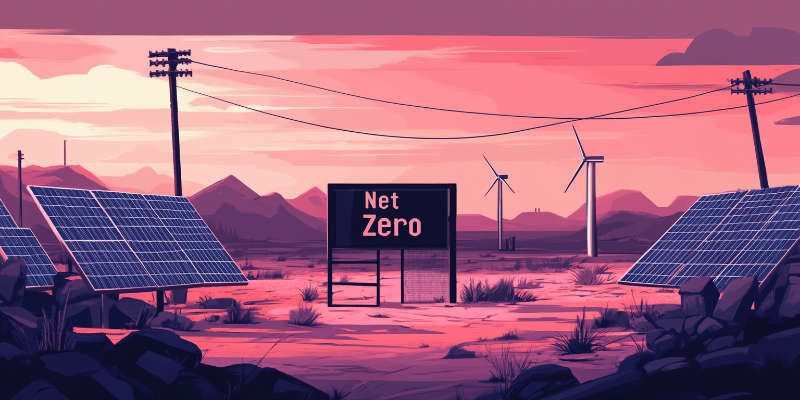The Scam of Net Zero, Clean Energy, and Renewables

The push for “net zero” and the global transition to “clean energy” and “renewables” have become defining political and economic narratives of the 21st century. Governments, corporations, and international organizations insist that the only path forward is through aggressive decarbonization, the expansion of wind and solar energy, and the replacement of fossil fuels with “green” alternatives. The narrative is presented as both a moral and scientific imperative: we must reach net zero emissions to “save the planet” from climate catastrophe.
But when you strip away the glossy public relations campaigns and the carefully crafted political messaging, the net zero agenda begins to look less like an environmental necessity and more like a vehicle for expanding control over energy markets, taxing populations, and enriching powerful interests. Beneath the surface, the clean energy transition is rife with hypocrisy, economic inefficiency, environmental harm, and blatant profiteering. Net zero is not about saving the planet — it’s about power, profit, and control.
The Political and Economic Foundations of Net Zero
The Origins of the Net Zero Agenda
The concept of net zero gained traction in the early 2000s as part of the broader push to combat climate change. In 2015, the Paris Agreement formalized the goal of limiting global warming to below 2°C — preferably 1.5°C — by drastically reducing greenhouse gas emissions. Countries pledged to achieve net zero emissions by mid-century, setting off a wave of policies aimed at decarbonizing economies through renewable energy, carbon taxes, and emissions trading schemes (IPCC, 2018).
The European Union quickly emerged as a leader in the net zero push, introducing the European Green Deal, which committed the EU to becoming the first carbon-neutral continent by 2050 (European Commission, 2020). Other governments and multinational corporations followed suit, with major oil companies like BP and Shell suddenly rebranding themselves as champions of green energy. The financial sector piled in as well, with banks and investment firms launching “green bonds” and climate-focused investment funds, promising to align financial markets with the net zero transition (BlackRock, 2020).
Who Profits from Net Zero?
The beneficiaries of the net zero agenda are not ordinary citizens or small businesses. The real winners are the financial institutions, multinational corporations, and governments that control the infrastructure of the so-called green transition. Renewable energy projects are heavily subsidized by taxpayers, and the profits flow to large corporations and private equity firms that invest in wind, solar, and battery production.
Carbon credit markets — where companies can “offset” their emissions by investing in green projects — have become lucrative financial instruments. Corporations can pollute as much as they want as long as they “offset” their emissions by buying credits, creating a market where pollution becomes a commodity rather than a problem to solve (Klein, 2019).
Governments benefit as well. Carbon taxes and emissions trading schemes generate billions in new revenue, which is often funneled into state-controlled green projects or redirected to politically connected industries. Meanwhile, taxpayers bear the cost through higher energy prices, increased taxation, and restricted access to affordable fuel and electricity.
The Myth of “Clean Energy”
Wind and Solar: Not So Green After All
Wind and solar are presented as clean, renewable, and environmentally friendly — but the reality is far more complicated. Wind turbines and solar panels require enormous amounts of raw materials, including rare earth metals like neodymium, dysprosium, and lithium. Mining these materials, often in developing countries under poor labor and environmental conditions, creates significant ecological destruction and human rights abuses (Behrens et al., 2019).
Wind turbines have a limited lifespan of about 20–25 years, and decommissioning them generates massive amounts of non-recyclable waste. The fiberglass blades, in particular, are notoriously difficult to recycle and often end up in landfills. Solar panels also have a significant environmental footprint, requiring large amounts of water and toxic chemicals in their production, and creating hazardous waste when they are decommissioned (Bishop et al., 2021).
Environmental Destruction in the Name of Green Energy
The push for wind and solar requires enormous amounts of land, leading to deforestation and destruction of natural habitats. Large-scale wind farms disrupt bird and bat populations, causing significant mortality rates among species already threatened by habitat loss. Solar farms require vast tracts of land, often leading to the displacement of communities and destruction of ecosystems (Lovich & Ennen, 2011).
In Germany, for example, the government’s push for renewables under the Energiewende policy led to the destruction of ancient forests to make way for wind turbines. The irony of cutting down forests to install wind turbines — in the name of saving the environment — underscores the hypocrisy at the heart of the clean energy agenda (Scheer, 2020).
The Economic Reality: Rising Costs and Energy Instability
The Unreliable Nature of Renewables
Wind and solar are inherently intermittent energy sources — the sun doesn’t always shine, and the wind doesn’t always blow. This means that renewable energy grids require backup from conventional sources like natural gas, coal, or nuclear power. Without reliable baseload power, grids become unstable, leading to blackouts and price spikes during periods of low renewable output (Joskow, 2019).
The reliance on intermittent renewables has already caused energy crises in Europe and California. In 2021, Germany faced record high electricity prices due to low wind output, forcing the country to rely on coal and imported natural gas to stabilize the grid. In California, rolling blackouts during heatwaves have become a regular occurrence as the state struggles to balance its grid with increasing renewable penetration (California ISO, 2020).
Rising Energy Costs for Consumers
The cost of renewable energy infrastructure is ultimately passed on to consumers through higher electricity rates and taxes. In Germany, the cost of the Energiewende has made German electricity some of the most expensive in the world, with households paying more than double the EU average for electricity (Agora Energiewende, 2022). Similar trends are emerging in the UK and other countries that have aggressively pursued net zero policies.
The Hidden Costs of Net Zero
The Rare Earth Problem
The mining of rare earth metals necessary for wind turbines, solar panels, and batteries is dominated by China, which controls over 80% of the global supply (International Energy Agency, 2021). This gives China enormous geopolitical leverage over the West’s energy transition. At the same time, rare earth mining produces toxic waste and radioactive byproducts, creating significant environmental and health risks in mining regions (Mancheri et al., 2019).
The Human Cost
The extraction of lithium and cobalt for electric vehicle batteries and solar panels has fueled human rights abuses in countries like the Democratic Republic of Congo, where child labor and dangerous working conditions are widespread (Amnesty International, 2016). The human cost of the green transition is rarely discussed in the glossy PR campaigns of renewable energy companies.
The True Purpose of Net Zero
The net zero agenda is not about protecting the environment — it’s about control. By shifting the global energy system toward state-controlled renewables and carbon markets, governments and corporations gain direct control over energy production, distribution, and consumption. Carbon taxes and emissions trading schemes create new revenue streams for governments, while renewable energy infrastructure creates investment opportunities for financial markets.
For ordinary citizens, the net result is higher energy costs, reduced economic freedom, and increased dependence on state-controlled energy systems. Farmers face restrictions on fertilizer use, homeowners face mandates to install expensive heat pumps, and drivers are forced into costly electric vehicles. Net zero is not about saving the planet — it’s about creating a new system of economic and political control under the guise of environmentalism.
Conclusion: The Green Mirage
The net zero and clean energy agenda is a carefully constructed mirage — a green smokescreen designed to justify higher taxes, increased regulation, and greater corporate and governmental control. Renewable energy, far from being clean and sustainable, is economically and environmentally costly. The beneficiaries are not the environment or ordinary citizens but the financial and political elite. Net zero is not a solution — it’s a scam.
Sources:
- Behrens, A., et al. (2019). “Rare Earth Mining and Environmental Impact.” Journal of Environmental Policy.
- Bishop, J., et al. (2021). “Solar Panel Waste and Recycling Challenges.” Sustainable Energy Journal.
- International Energy Agency (2021). “Global Rare Earth Supply Chain.”
- Joskow, P. (2019). “Renewable Energy and Grid Stability.” Energy Policy Review.
- Lovich, J. & Ennen, J. (2011). “Impact of Wind Farms on Wildlife.” Ecological Studies.
- Scheer, H. (2020). “Germany’s Renewable Energy Crisis.” German Energy Policy Journal.


















